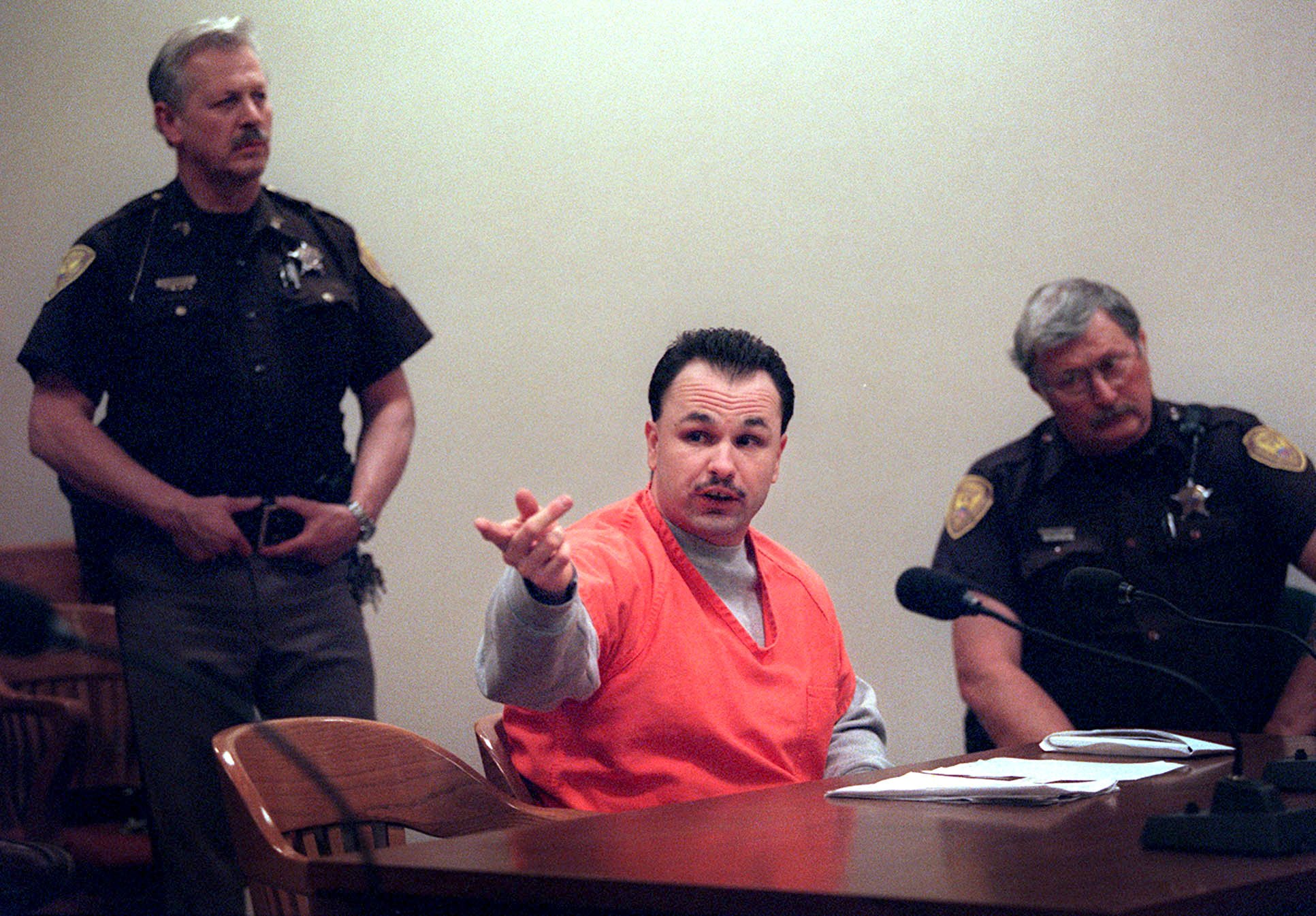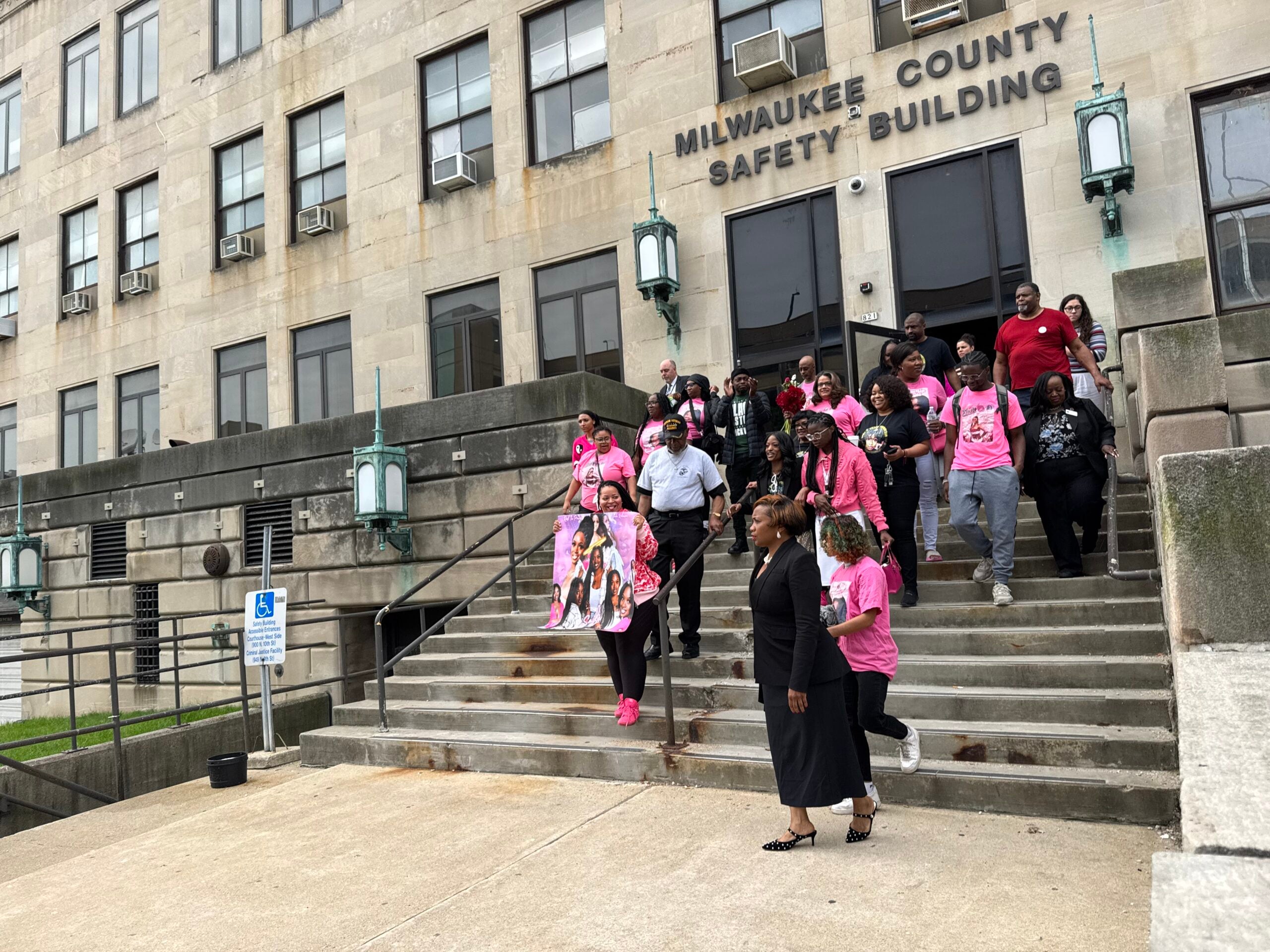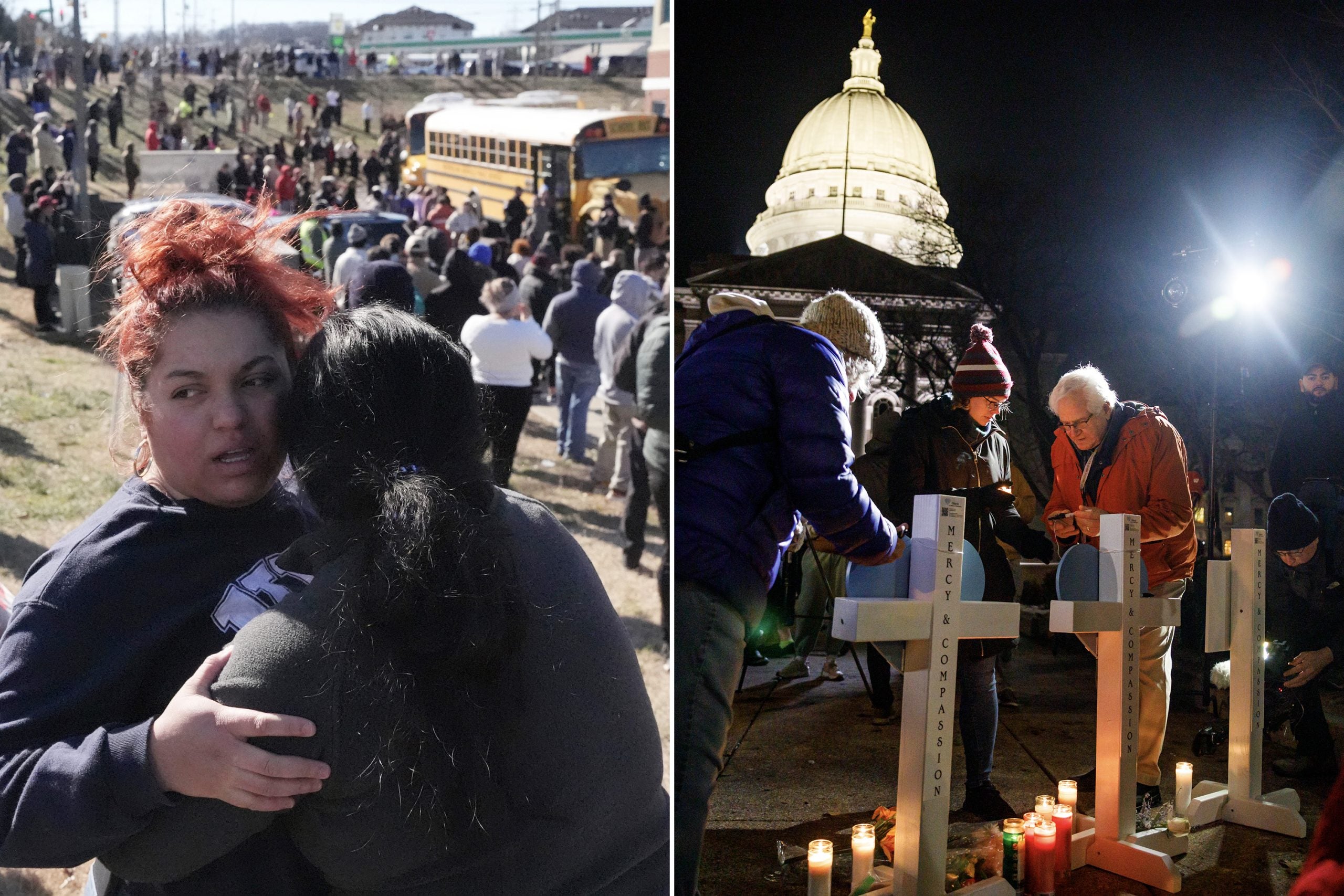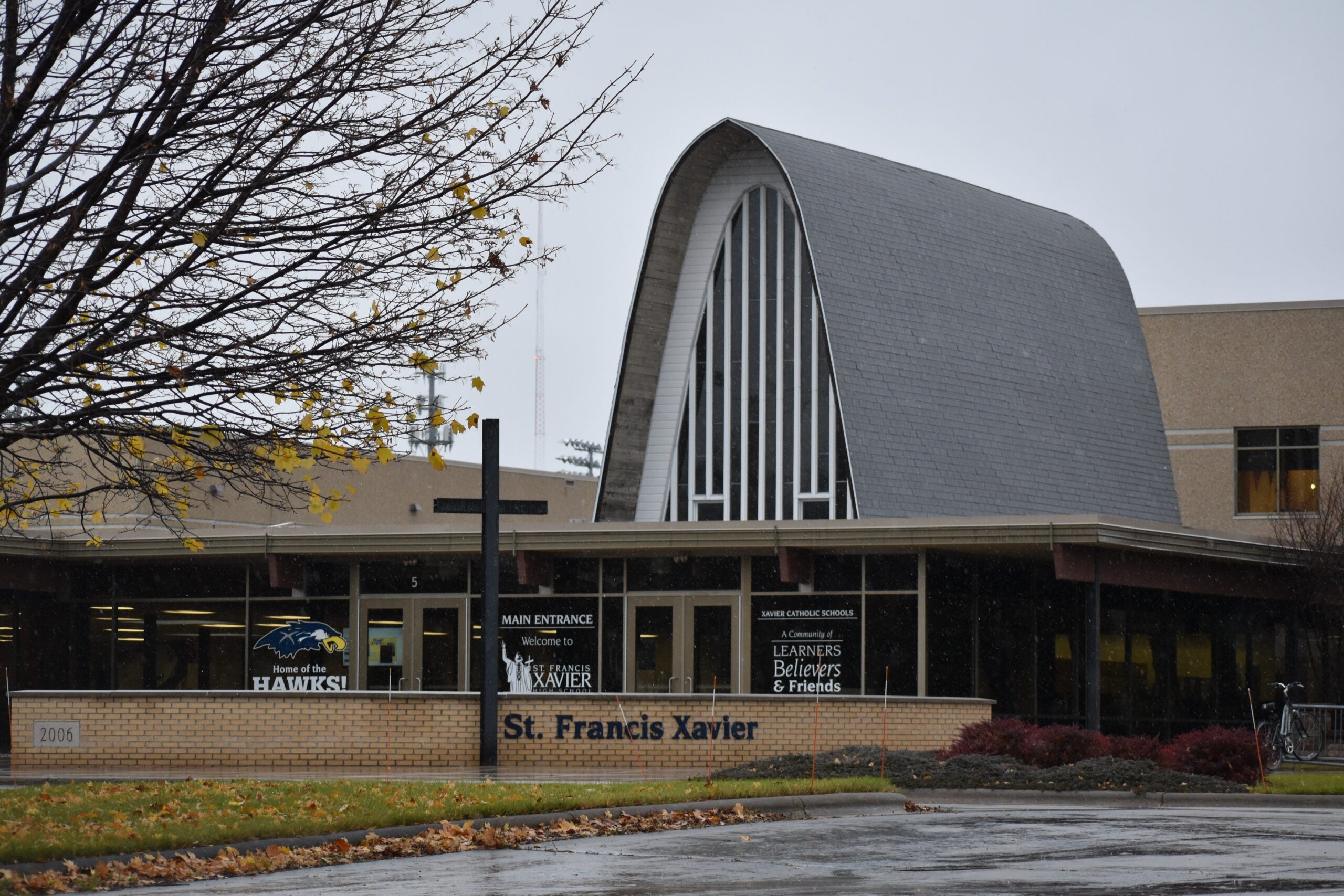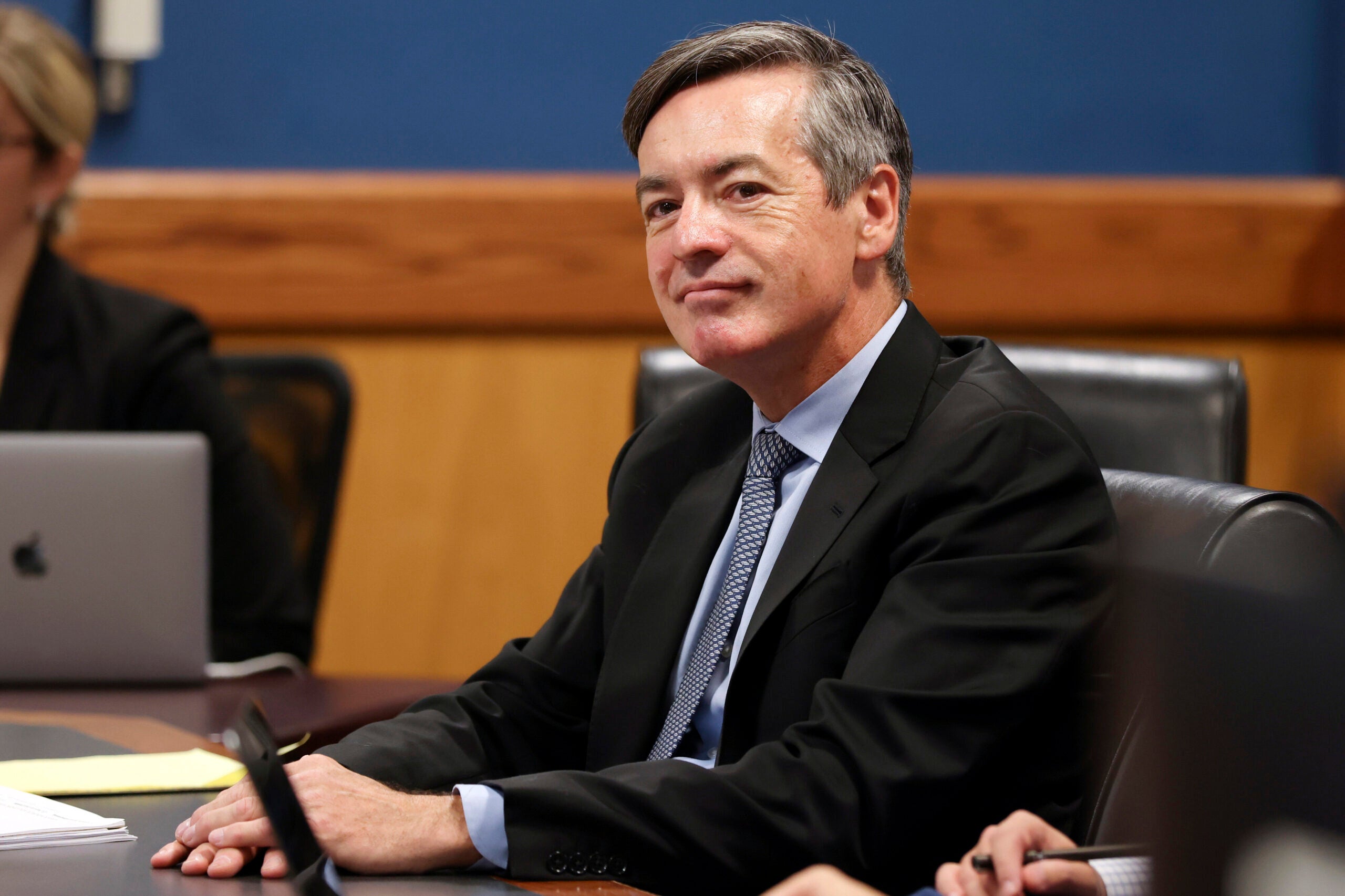Before we get started, a note about content. This episode contains graphic descriptions of a murder.
In the summer of 2000, 19 year old Shanna Van Dyn Hoven had just finished her first year at the University of Wisconsin-Madison.
News with a little more humanity
WPR’s “Wisconsin Today” newsletter keeps you connected to the state you love without feeling overwhelmed. No paywall. No agenda. No corporate filter.
She was back home, in Kaukauna. And she went for a jog on a route she often followed.
Van Dyn Hoven reached the last leg — a stretch of hill between woods and a quarry.
She began to scream. A neighbor named David Carnot, the son of a recently retired police officer, heard those screams and stopped his yard work. He told his story to local news reporters.
ARCHIVAL – DAVID CARNOT: You could hear the fear in her voice, that she feared dying. You could tell that something was drastically bad. It was something that you could not ignore.
Carnot lived above the road, behind the copse of trees.
ARCHIVAL – DAVID CARNOT: I started hollering, ‘Somebody dial 911!’ But no, nobody was here — nobody heard me, you know? I jumped the corner, and I run down the hill, and, um, I ended up out on the road.
Carnot says he found Van Dyn Hoven lying on the ground. Bleeding. Above her stood a man who seemed to have gotten out of a pickup truck.
ARCHIVAL – DAVID CARNOT: He was just standing there looking at her. And when I first come out of the woods, he didn’t see me. And then — and the minute I said something, he just looks at me, and then into the truck and drive and right for me.
Carnot says he ran towards a fence at the quarry’s entrance. As he started to climb over it, the truck rammed the fence and struck him in the leg. The driver then fled the scene — a fishing boat on a trailer bounced behind the truck
Channel 2’s Jerry Burke was on the story.
ARCHIVAL – REPORTER JERRY BURKE: Carnot called for help. Seconds later, police arrived but Shanna was already dead from multiple stab wounds.
Around the same time, across town, more police were flying down the road in hot pursuit of a Chevy pickup.
RADIO TRAFFIC – SGT. ROBERT PATSCHKE: (talking fades up) I’m gonna try to stop a pickup truck going on the highway 41 with three tires.
RADIO TRAFFIC – DISPATCHER: 10-4.
Finally, on a stretch of road near a water tower and two churches, police stopped the driver.
RADIO TRAFFIC: (emergency sirens)
RADIO TRAFFIC – POLICE OFFICER: (talking fades up) He’s going down into the ditch!
Officers approached the vehicle with their guns drawn. The driver stepped out. He was shirtless, wearing jean shorts and sandals.
Police said that the man had what looked like dried blood on his arms, chest, stomach, legs and feet.
On his upper arm, he had a tattoo that read “KEN.”
Police identified him as Ken Hudson.
Investigators say they found a bloody knife on the driver’s side floor and Van Dyn Hoven’s blood on the passenger seat. And the case against him seemed open and shut.
And look, I have spent months investigating this one case. I have hundreds of pages of notes.
The thing is, there’s a litany of holes in this so-called rock-solid case. They suggest that the investigation by police and the prosecution by Outagamie County District Attorney Vince Biskupic were anything but open and shut.
From Wisconsin Watch and Wisconsin Public Radio, I’m Phoebe Petrovic, and this is Open and Shut.
MIKE BALSKUS: It seemed like a pretty much, open shut case.
KATE O’BRIEN: I mean, this was open and shut.
JERRY BURKE: Nobody would have had to lie. It was an open and shut case.
DANITA METKO: Testing? Hello. (laughs)
It’s possible that Ken Hudson’s case never would have come to our attention, if not for a different prosecution, against a different person: Hudson’s ex-girlfriend. Her name is Danita.
DANITA METKO: Okay. Um, Danita Metko.
Back then, she went by another name, Danita Scharenbroch.
At the time of the murder, Metko and Hudson had been dating for about a year. They lived together with her two children at a mobile home park in a village near Kaukauna. The morning of the murder, they’d all been up north together, camping and fishing.
Metko received the news of Hudson’s arrest with disbelief, shock.
DANITA METKO: I didn’t think Ken was capable of that. I mean, he was a bumbling, stumbling fool half the time. I will say that. I always said he was an accident waiting to happen, but not a murderer.
But police told her, everybody’s capable of murder.
DANITA METKO: I’m believing everything they’re telling me. He did it, they found the knife, blah, blah, blah, all that stuff. I mean, I have no reason ever not to believe the police!
But as the investigation continued, Metko had a number of unsettling experiences with the police. She says they told her that she might be a suspect — even though at the time of the murder, she was at home waiting for a pizza delivery. And early on, police asked Metko to drive back north to figure out where Hudson had bought the knife — which was odd because police had already found the receipt for the knife in Hudson’s pocket.
Metko eventually felt so rattled that she hired a lawyer for herself. Just in case.
And her faith in the police — and what they told her — faded.
DANITA METKO: I started to believe maybe Ken really wasn’t guilty of this. Maybe it wasn’t like they were saying. I was praying to God day and night constantly asking him what I should do.
One day, Metko was doing her laundry.
DANITA METKO: And all of a sudden it was like, I could hear this voice. I know. I know it sounds funny. You got to have faith to believe it. It was just like, it was like, ‘Stick by him and help him.’
Metko walked to the mailbox, and found a letter from Hudson. It said quote: “Nobody’s ever stuck by me and helped me.”
DANITA METKO: Same words! And I’m like, I fell down on my knees and I, I felt, God really said, ‘Stick by him, help him.’
And so, she did. Metko started visiting Hudson in jail. Believing him when he said he was innocent.
And then, after Hudson had been in jail for several months, Kaukauna assistant chief of police John Manion and another officer visited Metko at work. She managed a Subway sandwich shop.
DANITA METKO: And they said, ‘We’re here to let you know that there’s a no contact order and you’re not supposed to be visiting Mr. Hudson.’
A court commissioner had ruled Hudson couldn’t speak to anyone listed in the criminal complaint filed by district attorney Vince Biskupic — and Metko was a possible witness.
DANITA METKO: And I said, ‘Really?’ I said, ‘Manion, when I asked you if I could visit, you said I could.’ He goes, ‘I don’t remember that.’ He’s the one who gave me the number to call the Outagamie County Jail to set up visiting!
So Metko asked her attorney.
DANITA METKO: He goes, ‘Danita, just stay away from anything to do with Biskupic. He will pull you into this. You have nothing to do with it. He doesn’t care about you or your kids.’ That’s what he said. ‘He doesn’t care.’ So I listened to him.
For a while, Metko stopped visiting Hudson. But then, Hudson’s lawyer told her it was fine, she could go. And so, she did.
And then, in February of 2001, police paid her another visit.
This time, it was towards the end of her shift, starting to get dark outside.
DANITA METKO: I was just about ready to leave. A police officer came into my work and asked me if I could take a ride down to, the justice center, the Kaukauna police wanted to talk to me. Now, I’m stupid. I’m really stupid. I’m like — probably should have called my lawyer or something.
But instead she grabbed her purse, and left with them.
DANITA METKO: I ride with him down there. Takes me in the back way. All of a sudden they start taking my purse, everything off of me. And I go, ‘What, am I being arrested?’
She was being arrested.
Her supposed crime? It was talking to Hudson on the phone. Violating that no contact order the cops had warned her about.
In order to post bail, Metko said she had to agree to some rules. She could not talk to her boyfriend, to Hudson.
DANITA METKO: Or I would be — my bail would be revoked and I’d be thrown into jail until my court date in May.
And so, about two weeks before Hudson went to trial, Metko suddenly stopped accepting his calls. And Hudson says that had a real impact on his case.
AUTOMATED VOICE: You may start the conversation now.
KEN HUDSON: Hey! How you doing, Dee?
Dee Hall, you’ll remember, is my boss at Wisconsin Watch. In 2019, Dee hired me to investigate potential discrepancies in Hudson’s case.
DEE HALL: I have Phoebe Petrovic with me today.
KEN HUDSON: Stevie?
PHOEBE PETROVIC: Phoebe.
For 21 years, Hudson has worked tirelessly in his prison cell, poring over police reports and photographs, scrutinizing their contents for any contradictions.
In Hudson’s telling, he was in the wrong place at the wrong time.
KEN HUDSON: I see the victim standing on the side of the road, waving her arms and screamin’. So I seen that she was covered in blood. And so I get out of my truck and I run around to where she was standing. And I’m like, ‘What happened? What’s going on? What’s going on?’ You know? And she couldn’t say nothing at that point. Didn’t say nothin’. So I’d open up the passenger side door and I told her to sit on the seat, which she did. Right at that time, I hear screaming in the woods, a male screaming.
The voice Hudson heard was David Carnot’s. That neighbor who told reporters about running to Van Dyn Hoven’s aid.
Hudson says at that point, Van Dyn Hoven fled the truck and crumpled to the ground.
Hudson says he thought Carnot was the killer. And he was scared. So he jumped into his truck and hit the accelerator. He smashed into the fence, then reversed and took off.
A couple blocks away, Hudson noticed that the fishing boat was falling off the trailer. So he stopped, released the boat and left it lying on the side of the road.
Soon, a patrol officer spotted the odd vehicle.
RADIO TRAFFIC – DISPATCHER: (talking fades up) It’s a dark, Chev, dark blue, pulling a boat trailer on three tires, going 75… (talking fades down)
Empty boat trailer, missing tire.
KEN HUDSON: And then he started chasing me and I panicked because I had marijuana on me and I was drinking and my driver’s license was revoked.
Hudson had also taken some valium. As for what police found when they pulled Hudson over — the knife in the truck and the blood on his body — we’ll get to that.
As Hudson awaited trial, he appeared in court — and the news — a lot.
JERRY BURKE: He was like a belligerent kid. He was like a teenager with attitude. Every time we went to court, we went, ‘What’s Kenny going to do today?’
That’s TV news reporter Jerry Burke again.
A Supreme Court decision guarantees everyone facing felony criminal charges an attorney, even if they can’t pay. Hudson had a number of court appointed lawyers. His first set withdrew because of a conflict. But that wasn’t the end of it.
JERRY BURKE: And he went through attorneys like water. He always said they weren’t doing their job.
On the advice of his first set of lawyers, Hudson had entered an insanity plea — arguing that even if he had committed the crime, he didn’t have the capacity to understand what he was doing.
But at the same time, Hudson was also pressuring his lawyers to demand more evidence from Biskupic — hoping to prove his innocence.
JERRY BURKE: Nobody was good enough for him.
As the trial approached, the judge agreed to appoint one last lawyer.
ARCHIVAL – JUDGE: By the way you better learn to cooperate with your new attorney because there won’t be another one.
AUDIO – REPORTER JERRY BURKE: This means Hudson’s trial is going to be delayed at least… (talking fades down)
The new lawyer was named Ed Carns.
You probably can guess what happened next.
ARCHIVAL – REPORTER JERRY BURKE: It was obvious Ken Hudson was in a hostile mood when he slammed down some papers next to his attorney in court. Hudson said he wanted the court to fire Ed Carns.
ARCHIVAL – KEN HUDSON: He hasn’t done anything. I don’t know what he’s done in my case. He won’t tell me. He’s never gone over anything with me.
The judge told Hudson he had 11 days to hire a new attorney with his own funds.
JERRY BURKE: And I dare anybody to sit in that courtroom with the shenanigans he was pulling and not say, ‘Okay, enough’s enough. Behave yourself or else you go to your room.’
And here’s where Danita Metko’s arrest becomes so important.
Metko had agreed to call Hudson’s uncle — who was living in New York — to ask if he would pay for a new lawyer.
DANITA METKO: So that particular weekend, Ken had called me numerous times. You know, it was all about talking about an attorney.
That Monday morning, with seven days left until Hudson’s deadline to get a new attorney, Metko headed to her shift at Subway.
DANITA METKO: And my sister, she called me at work in the morning and said, ‘Look it, Ken called me. He said he couldn’t call you; the number was blocked from the jail. He couldn’t call our Mom; the number was blocked. He couldn’t call anyone in New York; the number was blocked.’
And I’ve already told you this next part. Later that day, police officers showed up at Metko’s work and arrested her for supposedly violating a non-contact order by speaking to her boyfriend on the phone. And remember, in order to post bail, she says she had to agree to new rules. She could no longer speak to Hudson. She couldn’t help him get a lawyer.
So, just two weeks before trial was set to begin, Hudson returned to court without a new attorney.
ARCHIVAL – JUDGE: You don’t have a name to give me.
ARCHIVAL – KEN HUDSON: Well obviously because I —
ARCHIVAL – JUDGE: There’s a delay—
ARCHIVAL – KEN HUDSON: Because I can’t even contact my family.
ARCHIVAL – JUDGE: I’m not going to argue with you.
ARCHIVAL – KEN HUDSON: Alright don’t argue, don’t argue.
The judge had had enough. Hudson would have to represent himself.
Representing yourself in court is a constitutional right. But it’s one that a legal scholar once called quote “the right to shoot oneself in the foot.”
Hudson goes to trial after the break.
—
Hey Open and Shut listeners. Investigative journalism like this costs time and money. Getting these stories right takes research over weeks, months and — in this case — years. That’s where you come in. Your support of in-depth and independent journalism makes everything we do possible. Support fact-checked journalism that has a direct impact on people’s lives by making a donation to Wisconsin Watch and Wisconsin Public Radio.
Learn more and donate to Wisconsin Watch and WPR at wisconsin watch dot org and WPR dot org. Thank you.
—
JERRY BURKE: When Hudson went on trial, (sigh) it was a circus.
Ken Hudson’s trial took place in March 2001 — about 8 months after the murder.
Hudson wasn’t totally alone at the defense table — the judge had ordered Ed Carns to remain as standby counsel — basically coaching Hudson through procedure.
For as much as I’ve reported on Vince Biskupic, read about him, talked about him, he’s never agreed to an interview with me. And the only time I’ve ever heard his voice is in court recordings, like this one.
ARCHIVAL – VINCE BISKUPIC: The defendant’s actions relate to his anger, to rage and ultimately evil.
Biskupic argued that Hudson was mad at Metko and his mother — whom he’d fought with the weekend that Van Dyn Hoven died.
ARCHIVAL – VINCE BISKUPIC: You’ll learn from the evidence and testimony that peace met anger, that innocence met evil, that flesh was met with a blade and ultimately life met death.
At the start of the trial, Hudson asked the judge to suppress a key piece of testimony.
Here’s why.
On the night of the murder, the police took Ken Hudson to the hospital to be checked for injuries. And while he was there, he was swabbed for evidence and read his Miranda rights. Hudson says he asked for a lawyer.
But police never called one. Hours later, police say, Ken Hudson confessed on videotape to killing Shanna Van Dyn Hoven.
So when Hudson’s trial began, Hudson wanted to keep that confession from being entered into evidence. And what happened next still makes him angry.
KEN HUDSON: And Biskupic says, ‘Oh, well, he never asked for a lawyer. The record show, the police report show that he only made an ambiguous request from an attorney and clearly was not invoking his right to counsel.’
An “ambiguous” request. Courts have ruled that police only have to give you a lawyer if you clearly, specifically ask for one. Biskupic told the court that records showed there was quote “no unambiguous request” for a lawyer.
The judge ruled that the testimony about the confession was in.
Now, police had recorded audio of Hudson at the hospital — and it should’ve captured Hudson being read his Miranda rights. The right to remain silent. The right to consult with an attorney. As prosecutor, Biskupic would have had access to that tape. The state says they gave it to Hudson’s investigator, who has since died. But for reasons that are still not clear, Hudson never received that tape.
And, speaking of tapes, there was another problem with that alleged confession from the night of the murder.
The videotape of that confession does not exist.
At trial, the police testified the videotape had accidentally erased itself. And Hudson brought this up, but it just became part of the circus.
ARCHIVAL – VINCE BISKUPIC: You told Officer Shephardson and Manion you forced the girl in the truck!
ARCHIVAL – KEN HUDSON: I never told them that. Where’s the audio and video? That they did the recording, but it’s, it’s erased. Where is that video, Vince Biskupic?
So, for those keeping score at home, that’s two tapes — the video tape of Hudson’s confession that had accidentally erased itself. And the audio tape that Hudson says he never received — the one where he asked about, or for, a lawyer.
On the third day of trial, Hudson submitted a motion to withdraw his insanity plea — insisting he hadn’t committed the crime at all.
And Hudson didn’t just argue that he was innocent. He claimed he had been framed.
ARCHIVAL – REPORTER: Hudson’s defense revolves around a conspiracy theory that police planted evidence and the State Crime Lab and DA’s office is in on it.
Hudson claimed the police tore open the package of a hunting knife he’d bought earlier that afternoon, smeared it with blood and planted it on the driver’s side floor of his truck.
ARCHIVAL – KEN HUDSON: How did that knife not appear in that photo, but in that one? And, this — this moved. This stuff moved. Now in the next picture…
ARCHIVAL – POLICE OFFICER: Was that a question?
ARCHIVAL – KEN HUDSON: Yes.
ARCHIVAL – POLICE OFFICER: That you just asked me?
ARCHIVAL – KEN HUDSON: Yes.
And remember how I said we’d get back to the blood on Hudson’s body?
Hudson had an explanation for that too. He said a Kaukauna police officer named Robert Patschke poured blood on him.
ARCHIVAL – KEN HUDSON: When I was in the back of the squad car, the officer threw that blood on me. And I said, ‘What are you doing? Stop doing that. What are youse doing to me?’
Biskupic pushed back.
ARCHIVAL – VINCE BISKUPIC: And so you’re saying that the police walked up to your car with a bucket of blood, a bloody knife, and, and some other — probably her hand with her fingerprint and put it on your car, is that what you’re saying?
ARCHIVAL – KEN HUDSON: That is absolutely correct. That is what I’m saying, and that is the truth.
KEN HUDSON: I just get really passionate because listen, it is the God’s honest truth that they did plant that knife in my truck and Patschke poured that blood on me. I’ll take a lie detector right now and pass that with flying colors. I’m telling the truth! Patschke did pour that blood on me.
Hudson didn’t call any witnesses other than himself. Toward the end of trial, he threatened his standby counsel, Ed Carns — and eventually asked to be taken out of the courtroom.
JERRY BURKE: How Judge Froehlich kept his cool through that whole thing, I don’t under — I mean, he deserves a blue ribbon. The DA, Vince Biskupic, deserves a blue ribbon.
With Hudson watching from a back room, Carns delivered the closing argument. And completely undercut Hudson’s case. He said, essentially, that the state hadn’t proven that Hudson had the intent to kill Van Dyn Hoven. He said nothing about Hudson’s claim that he was framed.
JERRY BURKE: The evidence was so overwhelming. When the evidence is the way it is, you go, ‘This is a slam dunk.’ And it pretty much was. I don’t even remember how long the jury was out. It wasn’t that long.
ARCHIVAL – REPORTER: (talking fades up) The guilty verdict brought about tears and smiles. Shanna’s father…
This is Appleton’s Channel 5.
ARCHIVAL – REPORTER: And while tonight’s celebration won’t erase the pain of losing Shanna, her family and friends say there is some comfort in knowing Hudson will be locked up for life.
Wisconsin does not have the death penalty. Hudson was given the maximum sentence — life in prison with no chance of parole.
JERRY BURKE: I think if Ken would have taken on an attorney and let the attorney do his or her job, we might have seen a different outcome. But because of his courtroom behavior, the verdict that we got is what we got.
But what Jerry Burke didn’t realize is Hudson was trying to hire an attorney. Danita Metko was trying to help him. But when Vince Biskupic had Metko charged, those efforts ended.
And it turns out, Metko’s arrest should have never happened.
Vince Biskupic assigned his deputy to handle the charges against Metko.
DANITA METKO: Fast forward to my court date in May after — long after Ken got already convicted, and they threw it out. The judge said, ‘She didn’t commit a crime. There was no crime committed.’
The circuit court and the Court of Appeals both said that Metko didn’t break any law. There wasn’t even a law for her to break.
So why was she arrested? Metko has a theory.
DANITA METKO: I was really the only person to help Ken. I was really his only liaison to maybe possibly getting him some money to help with an attorney.
We asked Biskupic if Metko’s arrest had anything to do with her attempts to help Hudson hire a lawyer. Biskupic did not respond.
But regardless of whether that was his intent, that was the effect. With Metko out of contact, Hudson had no way to get money to hire a private attorney.
And to me, this story really shows the power of the prosecutor. Biskupic’s office decided to charge Metko, even though courts later said she hadn’t done anything wrong. And it had a big impact on her life. Her mom had to take a mortgage out on her house to fund Metko’s defense.
Even today, Metko is convinced of Hudson’s innocence. She still visits him in prison and she’s put up a lot of her own money to help with his appeals.
Danita Metko is actually the reason my boss, Dee Hall, first started looking at Hudson’s case.
In 2005, Dee received a tip from someone else who believed that Metko had been arrested to keep Ken Hudson from hiring a lawyer of his choice. Dee was skeptical.
DEE HALL: Well, the first thing I thought is: ‘Everybody gets a lawyer.’
Dee and Hudson exchanged letters. And Hudson sent Dee hundreds of pages of documents. As she sifted through them, she found herself questioning how Vince Biskupic handled the prosecution.
DEE HALL: I don’t know that there was this, you know, aha moment where a bell went off in my head, but it was just more, ‘Okay, so that doesn’t make sense, you know, that doesn’t make sense.’ And that, that got me started. Now, do I have good answers to any of those questions? That’s the problem. That’s what we’re trying to do is figure out what those answers are.
Here’s just one example: Shanna Van Dyn Hoven’s blood wasn’t where you’d expect it to be. Investigators found Van Dyn Hoven’s DNA on Hudson’s right hand, but Hudson didn’t leave any traces of blood on the surfaces he probably touched over the course of the 16 mile car chase: not on the steering wheel, the gear shifter, the driver’s side floor, not on the boat or the trailer.
DEE HALL: It was notable for where the blood wasn’t.
And some of the samples that looked like blood on Hudson’s body were tested, and had no DNA in them at all.
I spent a lot of time questioning the forensics — the photos of the knife, the blood stains, the DNA. But as I looked deeper, the scientists I interviewed could not fully explain what caused the confusing DNA results. And based on my reporting, I am not convinced there was a conspiracy to frame Ken Hudson.
But one thing I do know: There are definitely problems in the police investigation and Biskupic’s prosecution.
Remember those two tape recordings I told you about? One that had been accidentally erased and one that Hudson didn’t get?
Well, several years after the trial, Hudson learned a few important things.
A forensic tape examiner looked into the Kaukauna Police Department’s video equipment. He concluded it was physically impossible for the videotaped confession to just accidentally “erase itself.”
And in 2007, Hudson finally received a copy of that other tape — the audio tape from the hospital. The one Hudson claimed recorded him asking for a lawyer.
KEN HUDSON: And those tapes prove beyond any doubt whatsoever that I was telling the God’s honest truth that I wanted to talk to a lawyer and — okay? And, and, and that is something serious, for a defendant to be able to prove that these police were lying.
I listened to that audio tape and read the transcript. And Hudson says, quote “I want to talk to a lawyer.” That’s not an ‘ambiguous’ request at all.
In 2011, the Wisconsin Court of Appeals acknowledged that that tape proved that Hudson had clearly asked for an attorney. Hudson argued that by continuing to question him, the police had committed a so-called Miranda violation.
Normally, the “remedy” for a Miranda violation is to exclude any incriminating statements made after the defendant asked for a lawyer. In this case, it would mean that Hudson’s alleged confession would be thrown out. He might even get a new trial.
But the judges decided they didn’t need to do that because of a legal standard called “harmless error.”
BENNETT GERSHMAN: You have the famous harmless error rule.
That’s Bennett Gershman, a law professor at Pace University.
BENNETT GERSHMAN: If the prosecutor did something wrong and engaged in an error, what an appellate court will typically do, because they don’t want to have to try cases over or over again, is how much did this violation matter?
Harmless error acknowledges that an attorney made a mistake or broke a rule. But, it doesn’t fix the error or sanction the person who made it.
BENNETT GERSHMAN: Usually they’re saying that the other evidence was strong enough so that this evidence didn’t really matter. In the larger scheme of things, they didn’t really matter because the jury would have convicted anyway.
Harmless error is a pretty common finding. The Innocence Network studied 660 confirmed cases of prosecutorial misconduct that occurred from 2004 to 2008. And in about 80 percent of those cases, the misconduct was considered “harmless.”
And of cases in that study where the courts determined the misconduct affected the verdict? Only one prosecutor was disciplined.
BENNETT GERSHMAN: And a rational prosecutor would probably say, ‘I’ve got the evidence. It’s very, very strong. I’m going to convict. And if I make errors, they’re not going to be seen as that consequential.’ So the rational prosecutor might have an incentive to engage in rule violations.
As I looked deeper into this case, I found myself asking, why? Why cut corners in a case that seemed open and shut? Harmless error might be an answer. As Gershman says, some prosecutors may feel like they have an incentive to engage in rule violations. Because, the verdict probably won’t change. And they, as prosecutors, will likely face no consequences.
But what if, someday, the courts decide that all of this — the Miranda violation, the lack of blood on the steering wheel, the questionable DNA evidence, even the arrest of Danita Metko — that all of this amounts to error that is considered “harmful?”
What happens then?
For that, I want to turn to one more person. Her name is Kate O’Brien.
KATE O’BRIEN: I’m usually very open minded about things. You know, I was wrongly accused of stealing somebody’s pencil in third grade, so I don’t — I, I make sure I don’t rush the judgment.
O’Brien was a minor witness in Ken Hudson’s trial. She told the jury that she saw Hudson driving erratically on the day of the murder.
O’Brien remembers sitting on the witness stand as she testified against Hudson — feeling chills like she was in the presence of evil. And more than 15 years later, O’Brien’s confidence in Hudson’s guilt has not wavered.
KATE O’BRIEN: With every fiber in my being he is guilty as sin. There is no question in my mind that, yeah, the police may have screwed up, but this guy did it. ‘Cause those two possibilities can happen at the same time. They can mess it up with him still being really guilty.
PHOEBE PETROVIC: You sat on the stand with him. You said he gave you chills. You felt like the presence of evil. As someone who is so close to this, if there’s even an inkling that parts of the prosecution could have been improper, like what, to you what effect does that have? What is the consequence of that?
KATE O’BRIEN: Uh, the consequence is I am scared to death. If that guy gets out. I helped put him away. I helped him get convicted. And it personally scares me, not just that this person might go free, but if there are other people who can ask for appeals based on this prosecutor not being the good guy I thought he was, you know, who else is in danger now? All the people who have, who were witnesses in his cases are now potentially in danger and that’s unforgivable. Especially because this, this was just so open and shut. It should have been open and shut.
And then O’Brien said something about former Outagamie County District Attorney Vince Biskupic that I was not expecting.
KATE O’BRIEN: This guy was trusted by us, and I vote. I probably voted for the guy, and he just put so many people in jeopardy. And I’m furious. I’m just, I’m furious. I want that guy to stay in jail and I want the prosecutor out of a job, and I want all the other conviction, convictions to stick that should’ve stuck. And if he put anyone away that’s innocent, oh, I hope he pays for it. I really do.
On the next episode of Open and Shut: a case of confirmed innocence and exoneration.
TRICIA BUSHNELL: When we convict someone based on their record, that real perpetrator can go on to hurt other people. And that’s what happened here.
To hear the related podcast, go to Open and Shut (wpr.org/openandshut) or wherever you get your podcasts. The nonprofit Wisconsin Watch collaborates with WPR and other news media and the University of Wisconsin-Madison School of Journalism and Mass Communication. All works created, published, posted or disseminated by Wisconsin Watch do not necessarily reflect the views or opinions of UW-Madison or any of its affiliates. This story is a collaboration between Wisconsin Watch and WPR as part of the NEW News Lab, a consortium of six news outlets covering northeastern Wisconsin.
